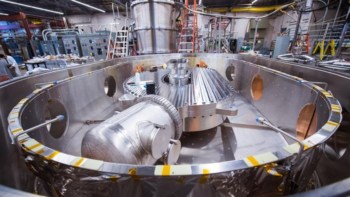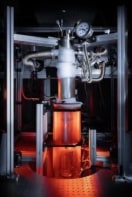
Two important breakthroughs in the understanding of iron-selenide superconductors have been made by two independent research groups. One team has shown that the electrons responsible for superconductivity in the material probably come from a specific atomic orbital. The other team, meanwhile, has measured the interaction between electrons and atomic vibrations in iron selenide, which is believed to be involved in its superconductivity.
The research could shed light on the mystery of why some materials based on iron selenide are superconductors at relatively high temperatures, which has puzzled physicists for more than a decade. While bulk iron selenide is a superconductor below 8.5K, this transition temperature can reach as high as 75K when an ultrathin trilayer of the material is grown on certain substrates.
Multiple orbitals
The superconductivity in iron selenide is thought to arise when electrons form Cooper pairs, which can then form a low-temperature quantum state that lets them flow unimpeded through the material. These electrons come from iron atoms in the material, and because of iron’s atomic structure, electrons from several different orbitals could be involved in the formation of Cooper pairs.
To find out how electrons in multiple orbitals pair up in the superconducting phase, an international team led by Séamus Davis of Cornell University and Brookhaven National Laboratory has used a scanning tunnelling electron microscope to characterize electrons associated with several different electron orbitals. The results suggest that one specific orbital is associated with superconductivity in iron selenide.
“We were able to show that almost all of the electrons in Cooper pairs in iron selenide were from a particular lower-energy orbital,” explains Davis.
Exciting vibrations
Meanwhile, a team led by Zhi-Xun Shen at Stanford University has used the Linac Coherent Light Source at the SLAC National Acceleratory Laboratory to look at the interaction between electrons and atomic lattice vibrations in iron selenide. Their experiment involved firing infrared laser pulses at the material to excite lattice vibrations before hitting it with ultrashort X-ray pulses and recording the resulting diffraction patterns to yield the positions of the atoms. At the same time, they shone ultrashort pulses of ultraviolet light at the sample, causing some electrons to be ejected. By detecting these electrons as a function of their emission angle and energy, they could characterize the electronic band structure of the material.
The measurements reveal that vibrations of the atomic lattice induce oscillations in the electronic structure of the material. Furthermore, the team found that the strength of the coupling between the atoms and electrons is 10 times stronger than had been predicted by theoretical calculations.
This could be an important discovery because the interaction between atomic vibrations and electrons is known to be a mechanism responsible for the creation of Cooper pairs. While the team says that the measurement does not prove that the strength of the interaction is solely responsible for high-temperature superconductivity in some iron-selenide-based materials, they believe it will provide important insights into the complicated interactions involved in the creation of Cooper pairs.
The studies are described in two different papers in Science.



